

Amy Walker is fun. A lot of people have been watching her video "21 Accents":
So far this is my favorite song from Radiohead's new album, The King of Limbs. The smearing of the vocal line helps transform it into pure melody. And if you listen to it on good headphones, and focus deep into the background, you'll hear a wealth of nearly subliminal mutterings and other spooky stuff. It's easiest to catch these in the beginning, in the dark spaces between the drums, before the vocals kick in:
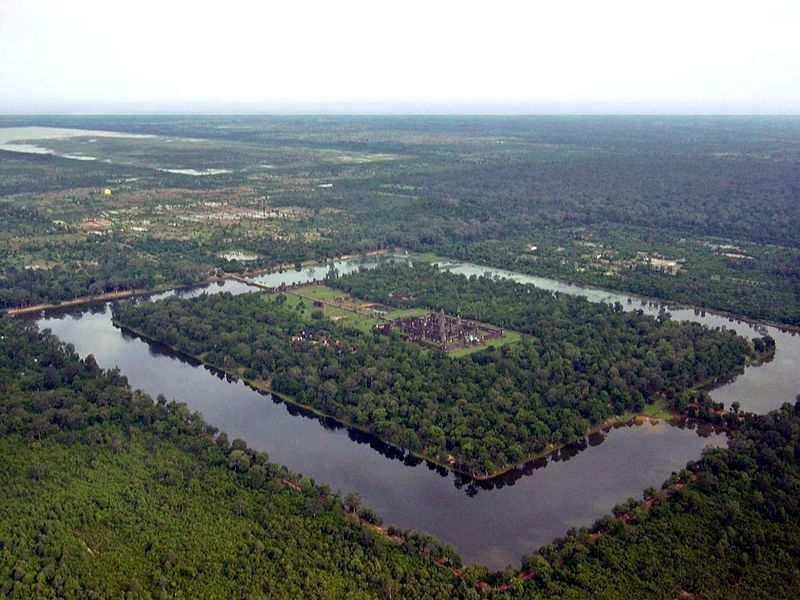
The area inside the moat is about a square kilometer — and there's a wall surrounding the whole thing, almost invisible here, 4.5 meters high. This was all a city when the Khmer king Suryavarman II had it built in the early 12th century. Now it's reverted to jungle except for a small portion near the temple proper.
The climb to the top of the central tower of Angkor Wat is steep and intimidating, but worthwhile:
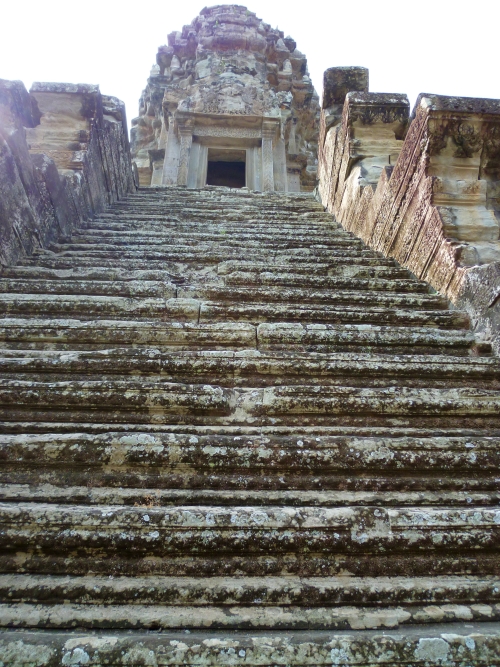
To get a better sense of the tower as it stands on the third level of the temple, just teleport yourself there and look around!
Once you get to the top of the tower, there's a lot to see. Here's the view to the west. See causeway road leading to the main gate? If you teleport over there. Then you'll see how huge this place really is!
In the middle of the picture above there's a small building. This was once a library. In fact there are two, one to the north and one to the south of that road. Here's a pony standing in front of the southern one:
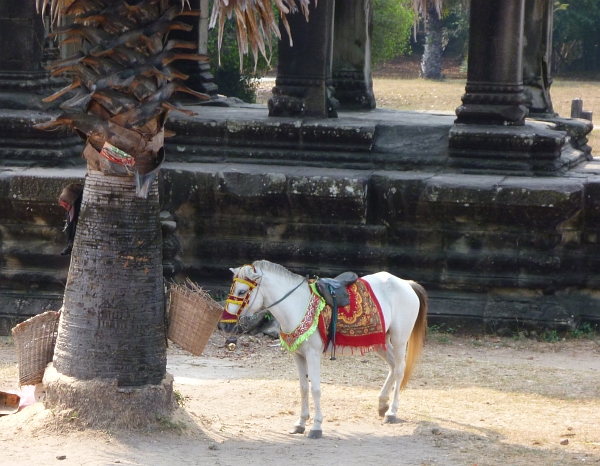
I suggest you teleport into the southern library and look around. Just like the temple complex itself, each library has four entrances: north, south, east and west. This had a cosmological significance to the Khmer. Angkor Wat was a microcosm of the world, with the central tower standing for mountain at the center of the world, Mount Mehru. Each library was a microcosm of this microcosm.
The Khmer were mainly Hindu, but Buddhism reached Angkor at the end of the 12th century, so we see its influence too. This was Mahayana Buddhism, not the Theravada Buddhism that's found in Southeast Asia today. I think this Buddhist statue is up in the central tower of Angkor Wat:
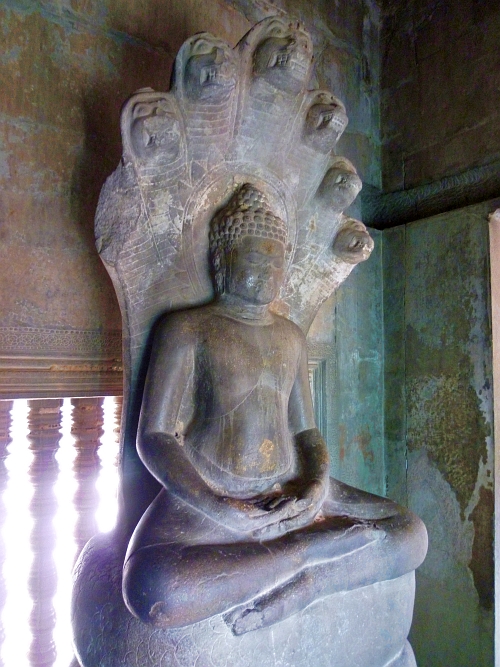
I believe this is the Buddhist teacher Nāgārjuna, sitting on a seven-headed nāga. In Cambodian legend, the nāga were a snake-like race of beings who possessed a large kingdom in the Pacific Ocean.
Going back down to the ground floor, you'll see many wonderful carvings.
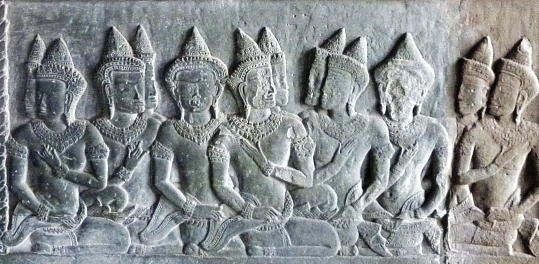
The sculptors of this culture had a healthy fondness for the female form and weren't embarrassed about it. 'Devatas' like these stand in a dignified way, while the 'apsaras' dance. Counting both kinds, there are a total of 1796 in Angkor Wat!
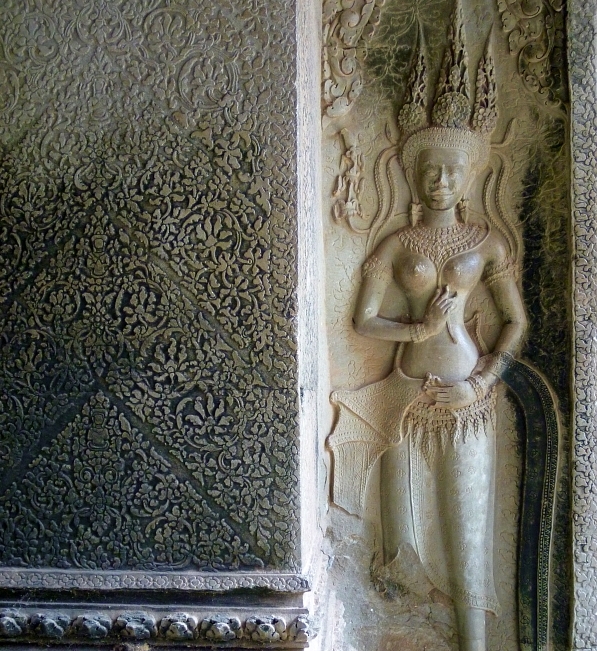
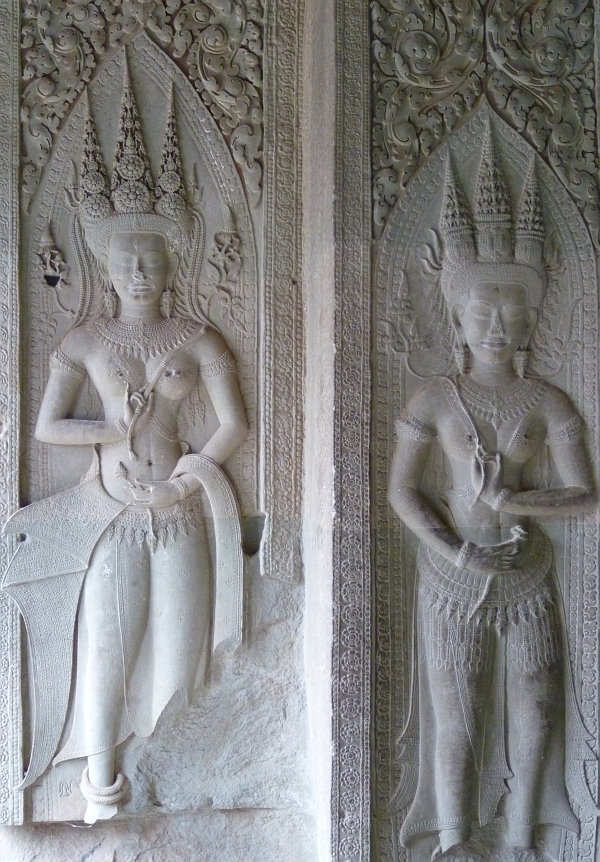
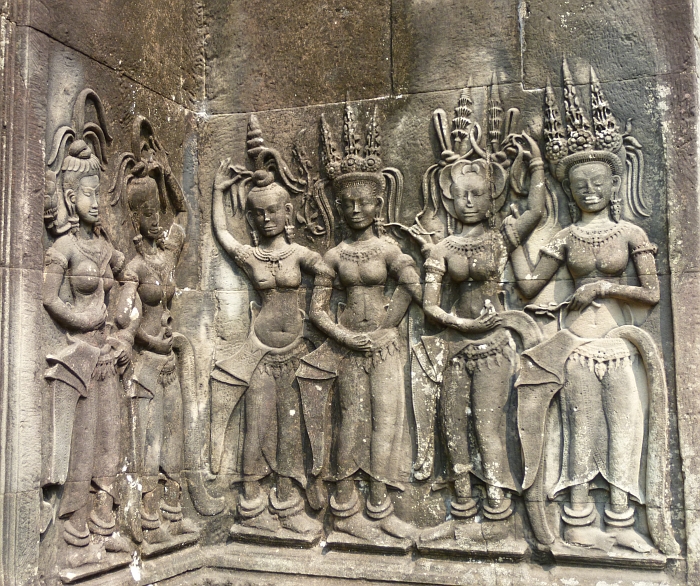
In Hindu myth, apsaras are female celestial beings who fly around, dance, change their shape at will, and rule over the fortunes of gamblers. But now the security guards in Angkor are called the Apsara Authority.
I enjoyed the contradictory connotations built into this term: it's a bit like a Nymph Squad, or Dryad Brigade. Their main job is to keep people from looting the temples, which extend over an area far more vast than Angkor Wat itself. Unfortunately some may be corrupt. That would not surprise me: the dark side of Cambodia today is the corruption of its politics. It's much better than in the Khmer Rouge days, of course—after that, they had nowhere to go but up.

The perimeter of the Angkor Wat temple features seemingly endless walkways... but they're lined with bas-reliefs—about 600 meters worth! Mostly they tell stories from the great Hindu epics: the Ramayana and the Mahabharata. But there's a section on the triumphs of Suryamvarman II, the Khmer king who ruled from 1113 to 1150 and had Angkor Wat built. And there's a section depicting heavens and hells. As in Dante, hell is more attention-grabbing: we see gluttons sawn in two, seducers torn apart by birds of prey and thrown into a lake of slimy pus, and so on.
I went to Angkor Wat on two separate days, because there's so much to take in... and even then, after several hours I was crying out for a bit of relief—any sort of relief except another bas relief!
I won't show you many of these bas-reliefs, but here's a tiny portion of an enormous one: the Battle of Kurukshetra, the climax of the Mahabharata, where the Pandavas and Kauravas fight it out and the Pandavas triumph.

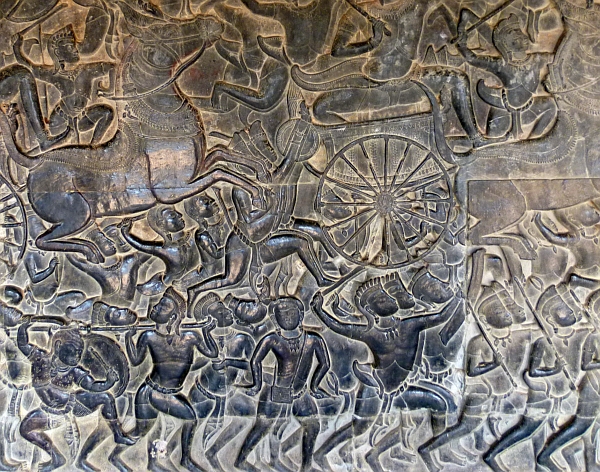
On this 49-meter-long wall, the rival armies march in from opposite ends in an orderly fashion, but action becomes utterly chaotic near the middle. So, it reads a bit like a story as you walk from end to middle.
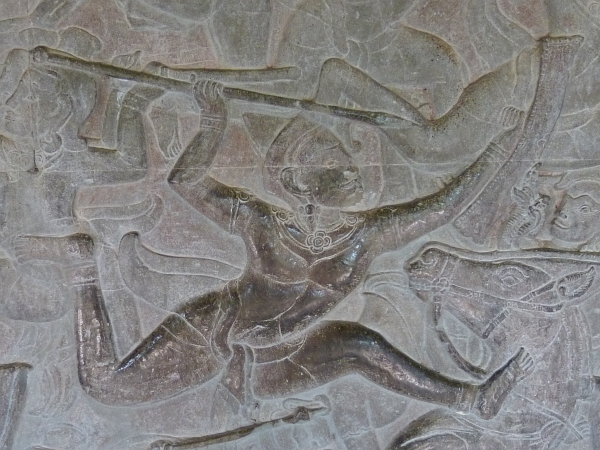
After each day in Angkor I'd head for the nearby town, Siem Reap, for dinner. It's bustling, packed with markets and restaurants, and it lives off tourist dollars. Good food is cheap, beer is cheap, everything seems cheap. You can live like a king in this country, where the average per capita income is about $700.
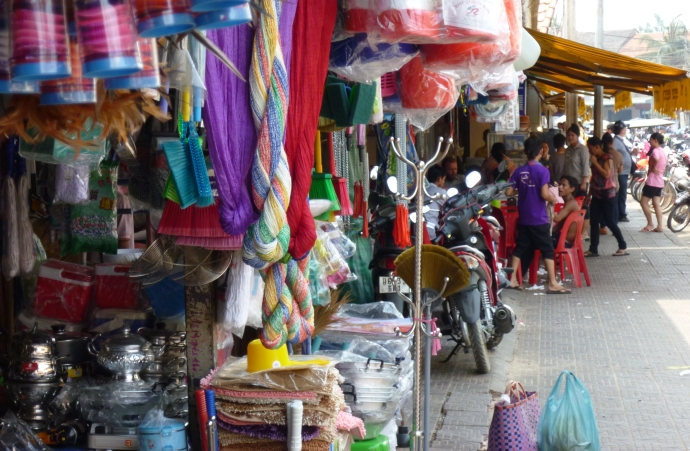
It can even make you feel a bit bad—and if you want to feel even worse, go visit the land mine museum! Under President Nixon, the United States dropped 2,756,941 tons of bombs on Cambodia in a 'secret war'. Secret from the Americans, that is—not the people being bombed. It started on March 17, 1969, with a bombing raid called 'Operation Breakfast'. The next day, Nixon's aide Haldemann wrote:
Kissinger's 'Operation Breakfast' a great success. He came beaming in with the report, very productive.
Of course the history is complex: things were already bad in Cambodia... and in 1976 they got much worse when the Khmer Rouge took over, made 2.5 million people leave the capital and simply walk out into the countryside, murdered all the educated people and professionals they could find, forced everyone to become farmers... and wound up killing or starving about 4 million. Picking wild berries was seen as 'private enterprise' and punished by death.
In 1979 the Vietnamese invaded and put an end to that, pushing the Khmer Rouge into the mountains... and gradually, and very imperfectly, things have been getting a bit better since then.
So have another beer, buy some stuff in the markets, tip the driver well and go to bed.
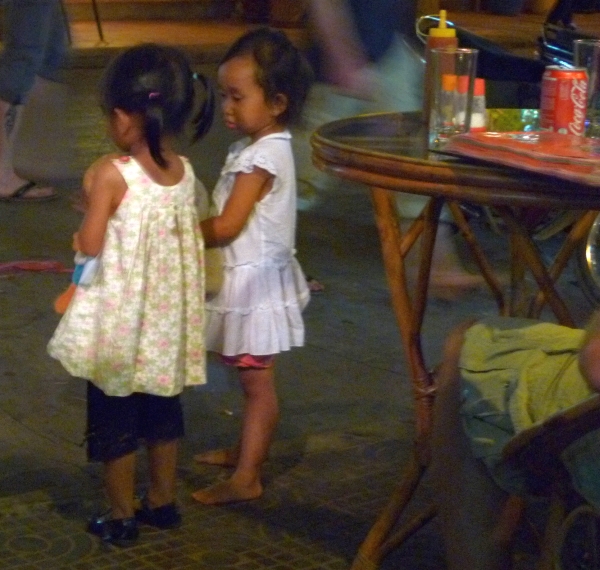
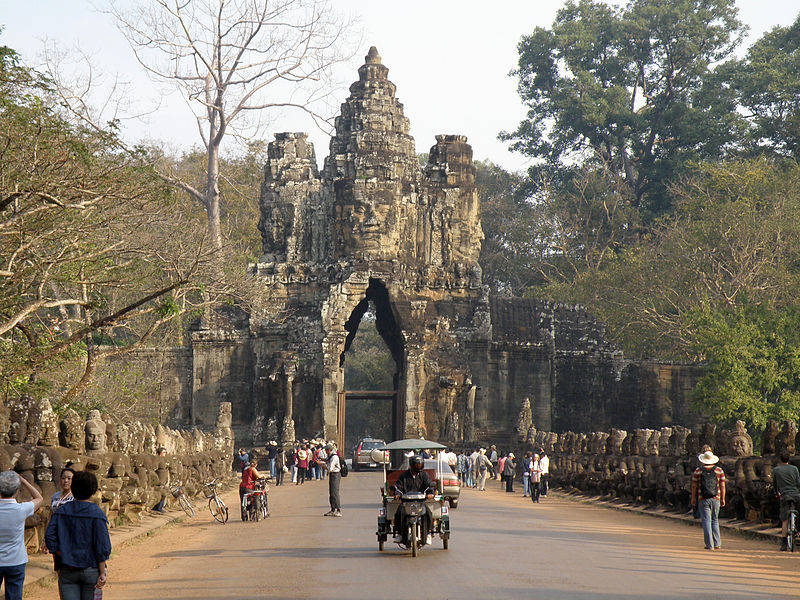
Here's a tuk tuk in front of a huge gate with four heads of Avalokiteśvara, flanked by rows of stone statues. Inside, there's a complex of temples in square 9 kilometers in area!
Let's start with the least impressive parts of Angkor Thom and work our way up, okay?
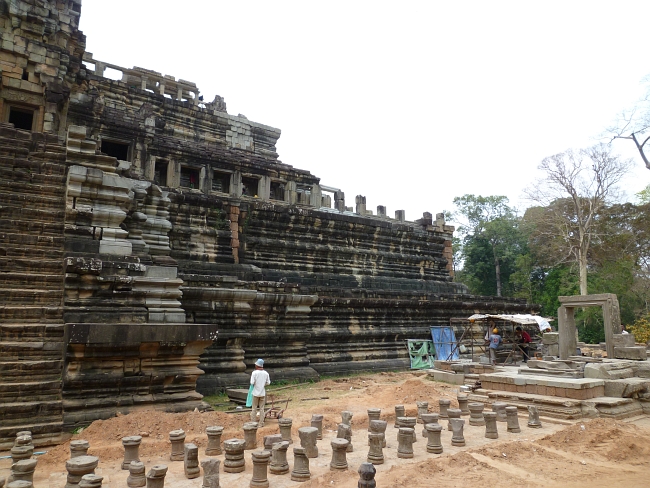
This is Baphuon. Each king built his own temple, and this was built in the mid-11th century by Udayadityavarman II. Once it held a 70-meter long statue of a reclining Buddha. Now, alas, that's gone. But here's the interesting part. The French began reconstructing this temple in the 1960's by taking it apart into 300,000 sandstone blocks. Each block was carefully painted with a number so they knew where it belonged. But when the Khmer Rouge swept into power in 1975, all the records were destroyed! It became the world's biggest jigsaw puzzle. It's now close to finished — but, umm, 10,000 blocks are still lying around out back.
You can teleport yourself to Baphuon and look around. Check out the blocks still lying around, and also the royal pools!
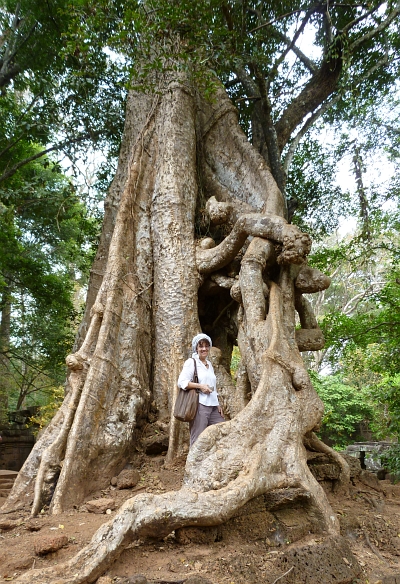
Here's Lisa behind Baphuon, en route to the next temple. The luxuriant jungle of Cambodia had completely overgrown all the temples by the time the naturalist Henri Mouhot 'discovered' them in 1863. When we get to Ta Prohm, we'll see what these trees can do to stone buildings after a few centuries: that temple was left in its natural state, and it's my favorite. You may remember it from the movie Tomb Raider.
(I put 'discovered' in quotes because in fact some of the temples were still being used when Mouhot showed up!)
En route to the next temple, called Phimeanakas, we saw this wonderful thing that was too small to even be in the guide book. Oh, how I would have loved this as a kid! Ruined, half-sunken structures have always excited my curiosity.
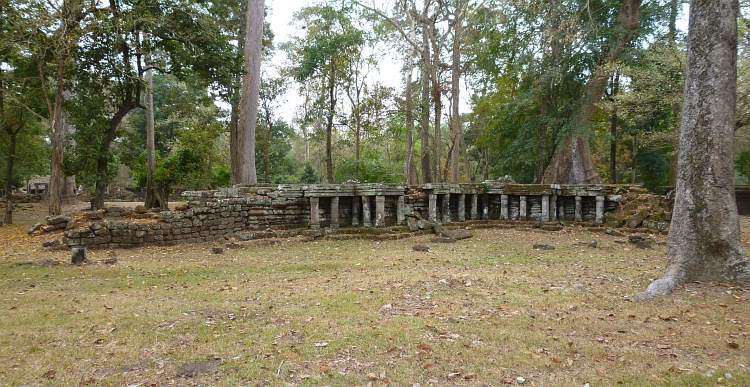
And here's Phimeanakas, directly north of Baphuon. It's small as these temples go, but small can be good: if nobody else is there, you can pretend you're a brave jungle explorer discovering it for the first time. It's fun to stand on top of this and look down. Wanna try? Go here. Unfortunately you'll meet a small pack of tourists, but that's very realistic.
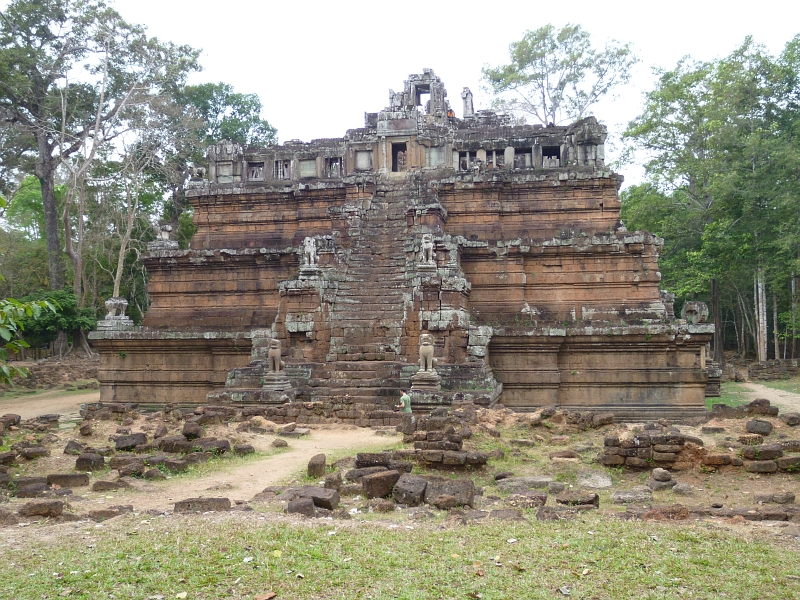
Phimeanakas is an old temple, originally built by the king Rajendravarman around 950. Legends say the the tower was inhabited by a nāga, or serpent, which would transform into a woman at night. The kings of Angkor had to make love with this serpent-woman every night, or disaster would befall the kingdom.
Here is one of the Khleangs, buildings across the way from Phimeanakas. Nobody knows what it was used for, though it makes a great place for kids to play:
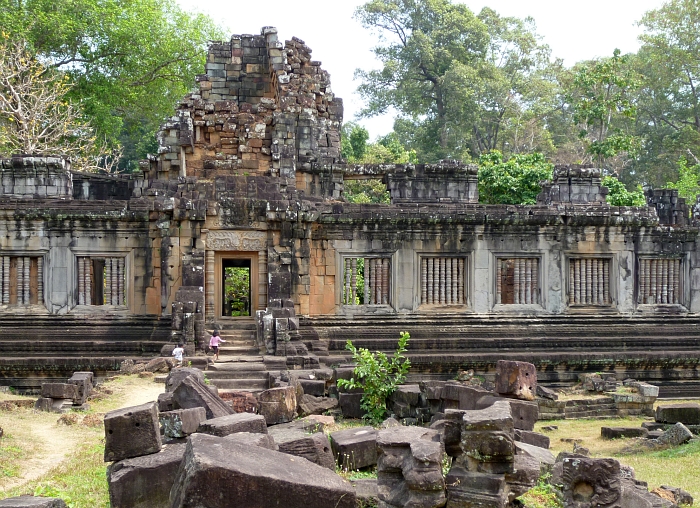
And a tiny bit south, here are some of the twelve Towers of Suor Prat. I just love their ramshackle condition and tall, skinny shape. Again, nobody knows what they were used for. You can see a statue of a nāga in front of the closest one here:
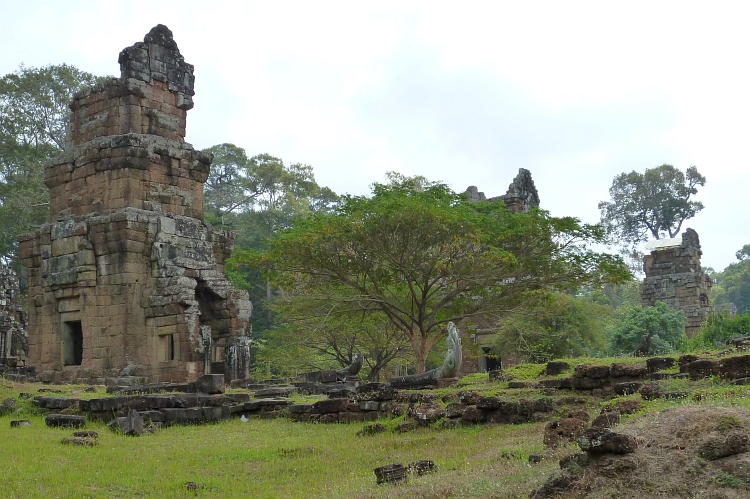
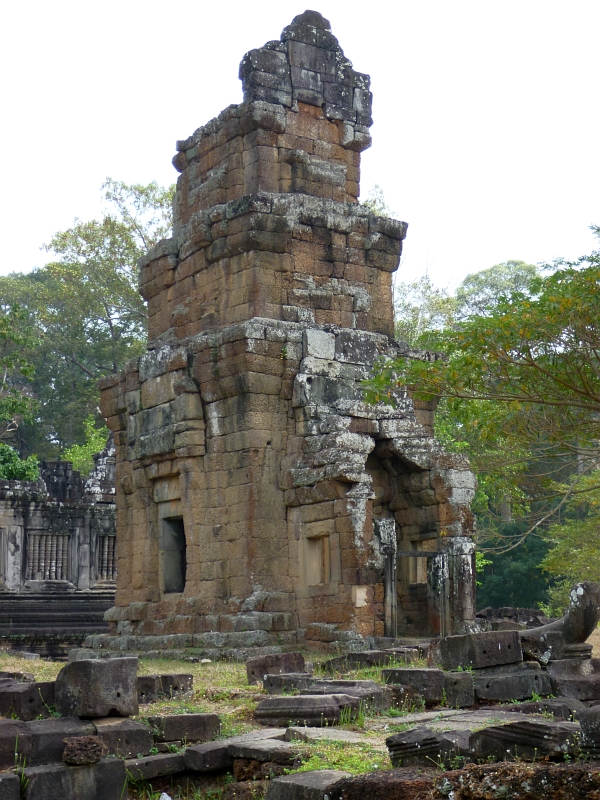
Okay: now for Bayon, the biggest temple in Angkor Thom. It's impossible to convey the whole in a single photograph! My shots came out looking like random piles of stone unless I zoomed in on small details. Luckily Meik Steuber made this computer model available on Wikicommons — so let's start with that.
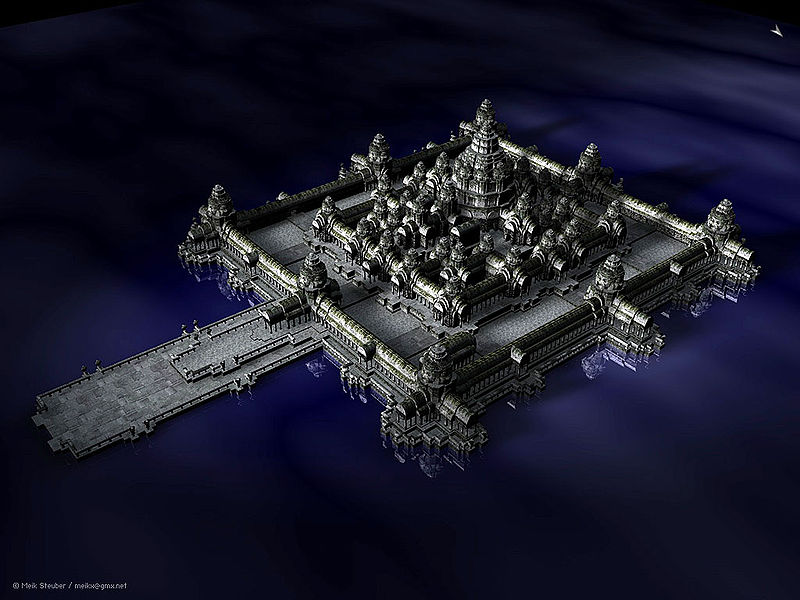
The symmetry is evident; what you can't see here is that all 49 towers are adorned with enormous stone faces of Avalokiteśvara, as we saw on the main front gate of Angkor Thom. In Mahanaya Buddhism, Avalokiteśvara represents compassion. As a 'boddhisatva', he made a vow to postpone his own nirvāṇa until he has assisted every sentient being on Earth in achieving the same. Nirvāṇa literally means 'blowing out': blowing out the fires of craving and aversion, leaving 'consciousness without feature, without end, luminous all around'.
Each tower of Bayon has four faces of Avalokiteśvara carved in the stone:
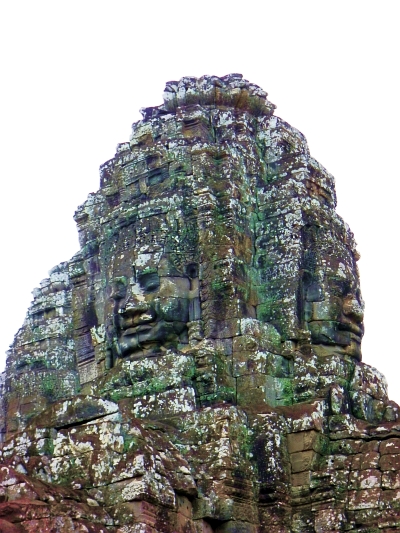
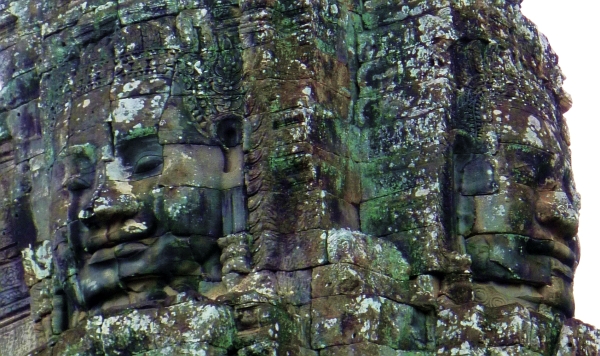
Bayon was built by King Jayavarman VII, a Mahayana Buddhist king of the Khmer empire, with construction starting roughly around 1200 AD. This empire lasted from 802 to 1401, with the first king founding Angkor as its capital.
Henry Flower contributed this nice photo to Wikicommons.
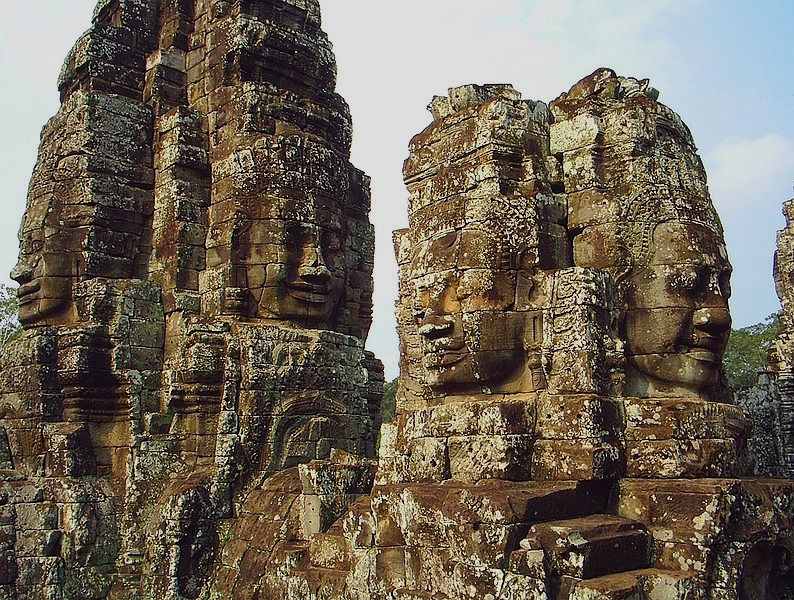
From a distance the big temple of Bayon in Angkor Thom tends to look like a pile of rubble — I've worked hard to avoid showing you photos that convey this impression. But as you get closer you see the giant stone faces of Avalokiteśvara, and as you get closer still you see many delicate carvings. Here are some lively 'apsaras': dancing celestial spirits.

Lisa found the bas reliefs at Angkor Wat a bit tiring because they're mostly battle scenes. Those at Bayon in Angkor Thom are far more diverse, including scenes of hunting, fishing, shopping, and household activities. These give us some rare glimpses of life in Cambodia back around 1200. No texts survive from this period, though there's a lot of writing carved into temple walls.
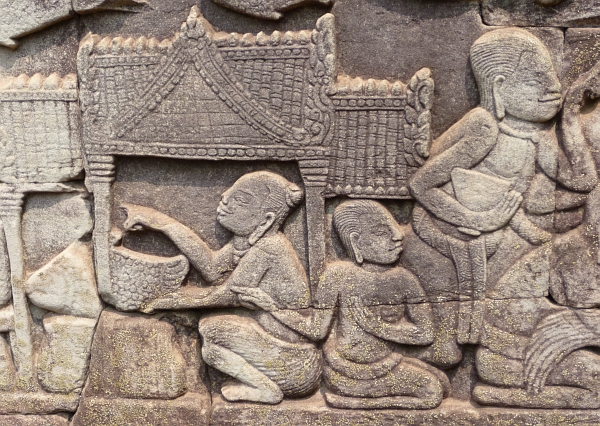
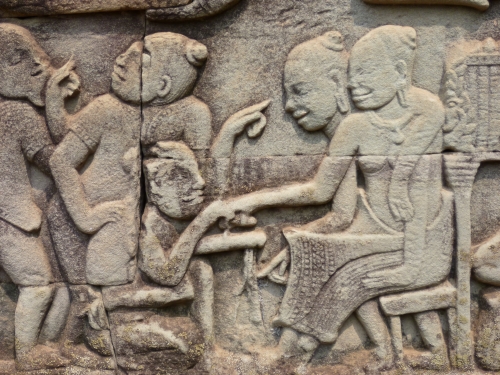

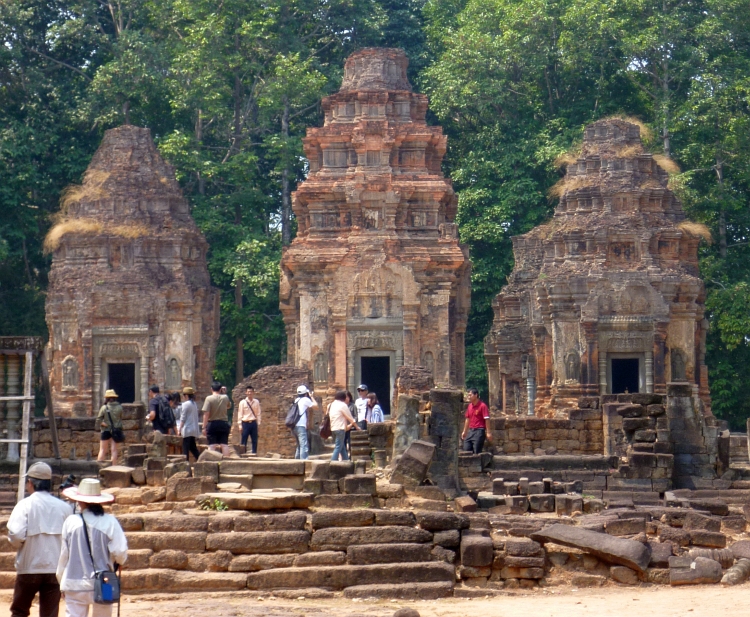

You can teleport yourself to Preah Ko and look around! There are actually six buildings here, not just three.
There are beautiful inscriptions on Preah Ko, written in Khmer script. This system of writing goes back at least to 611 AD, and it's still in use, though a couple of letters have been dropped. A lot of what we know about the history of the Khmer empire comes from inscriptions like these: as far as I know, no other texts survive.
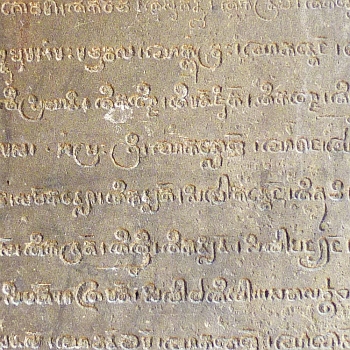
Below you see Lisa walking the long, hot, dusty trail to Bakong, near Preah Ko. There's something exciting about the moment when you first catch sight of a temple like this. Before you know what it's really like, you can imagine anything.
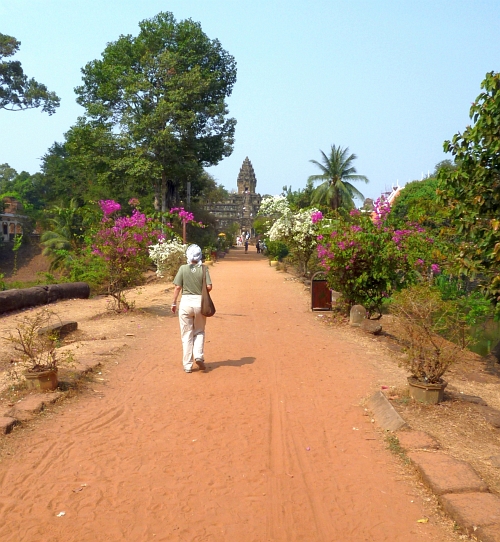
Many temples around Ankgor are modeled after Mount Meru, the center of the universe in Hindu cosmology. Bakong is the very first of these 'temple mountains'. It was begun shortly after the founding of Cambodia in 802, and completed in 881 under King Indravarman I.
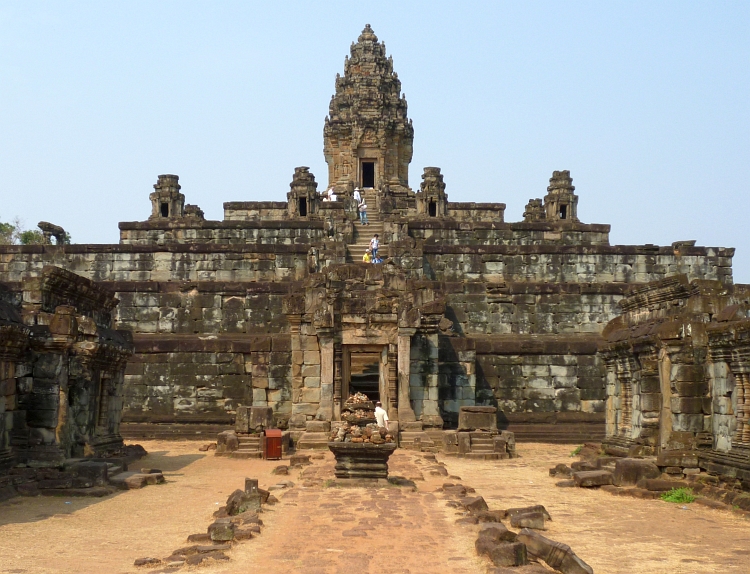
I had trouble capturing its grandeur in a single photo — you have to walk around to appreciate the geometry. Luckily you can teleport yourself to the location shown above, and do just that!
It's work climbing up the 'temple mountain' of Bakong, but you're rewarded by a splendid view. Go here to look around. Can you spot the statue I've photographed below? This statue, and indeed the whole temple, is made of sandstone. Later temples, like Angkor Wat and Bayon, were built using blocks of an iron-rich clay called laterite. That's a better choice, because it's fairly soft when first cut out of the ground, but it hardens when exposed to air!
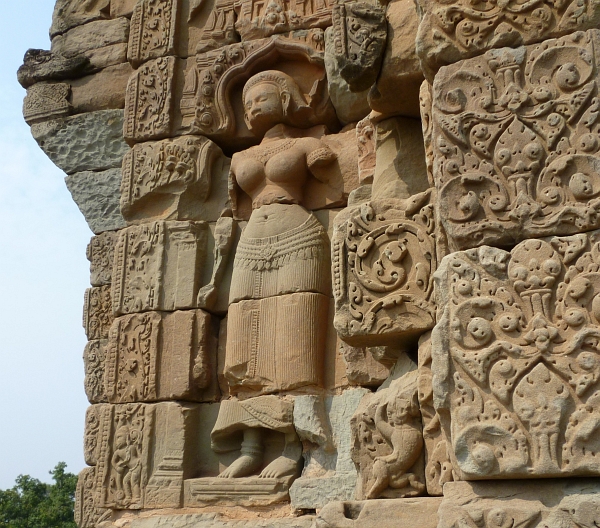
On our way out of Bakong we were serenaded by some musicians, and gave them some money:
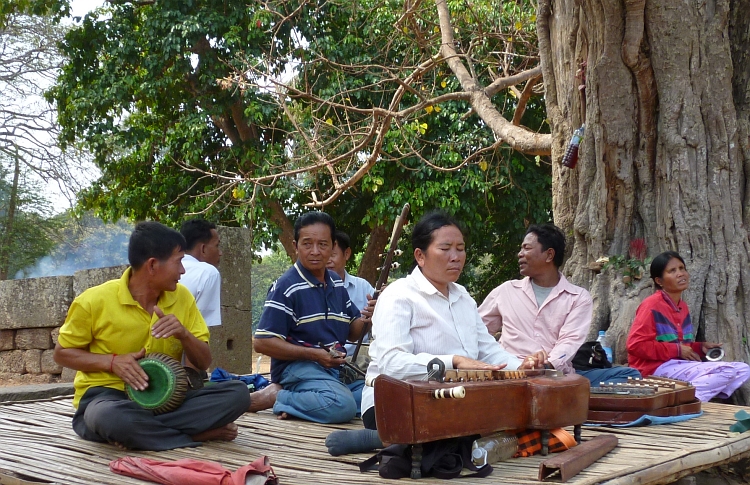
Blind musicians are common in Cambodia. I was told blindness is caused by malaria, but now I don't see that listed as a side-effect. Anyway, malaria is common, and we took malarone during our visit, as well as using mosquito repellant. Since it was the dry season, we only got a few bites, but the malarone was reassuring.
After visiting Preah Ko and Bakong we headed south to Kompong Phluk, a fishing village on the shores of a huge lake called the Tonlé Sap. Since we visited during the dry season, you might not see why this house on the outskirts of town needs stilts! But when it rains, everything changes. Note the boat at front left.
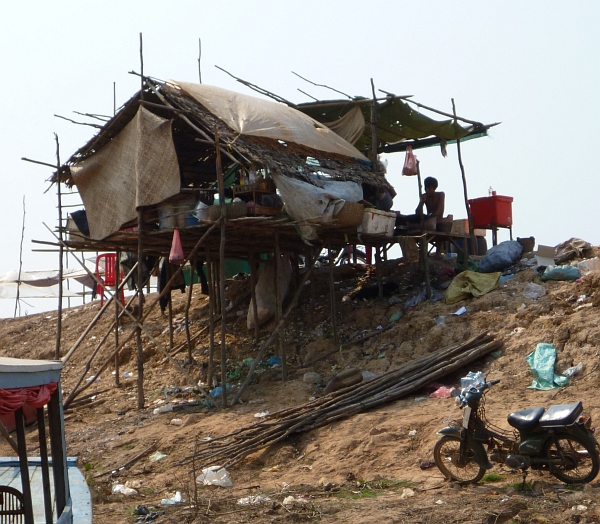
In Kompong Phluk all the houses are on stilts, and everyone knows how to swim. The villagers raise fish in the Tonlé Sap, which is the largest freshwater lake in southeast Asia. During the dry season, from November to May, this lake drains into the Mekong River near Phnom Penh. But during the monsoons, water flows back from the Mekong into the lake, and it grows six-fold in area! Fish from this one lake provide Cambodians with 60% of their protein intake. We took a boat ride down this muddy river into the Tonlé Sap and saw the fish farms.
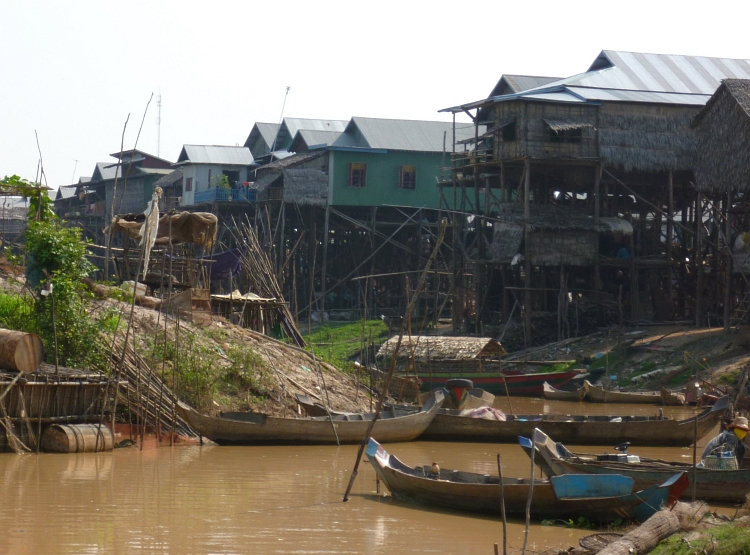
I don't know about you, but I need a map to feel I understand a place. Here's Cambodia, surrounded by Thailand, Laos and Vietnam — and with that big lake, the Tonlé Sap, at its heart. North of the lake is Angkor and the tourist town that supports it, Siem Reap. Water flows out of the lake into the Mekong River, which then goes past the capital, Phnom Penh.
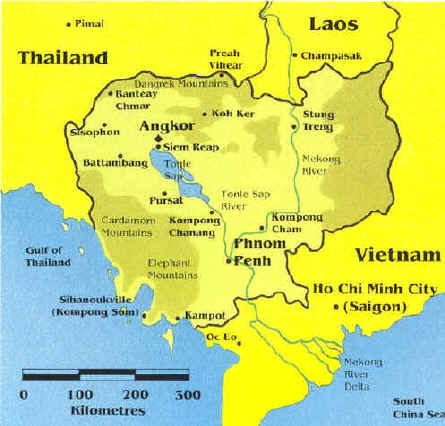
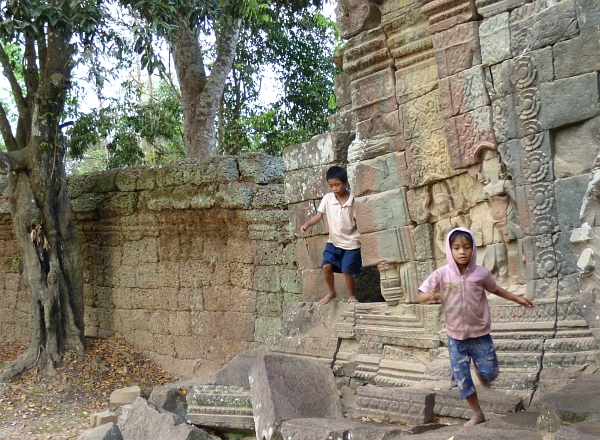
Ta Prohm was built in the 12th and 13th centuries, about 100 years after Angkor Wat. It was set up as a Mahayana Buddhist monastery and university by the Cambodian king Jayavarman VII. A large area — 1 kilometer by 650 meters — was surrounded by a wall like the one we see here. This area, once a thriving city, is now a jungle. In the center is Ta Prohm.
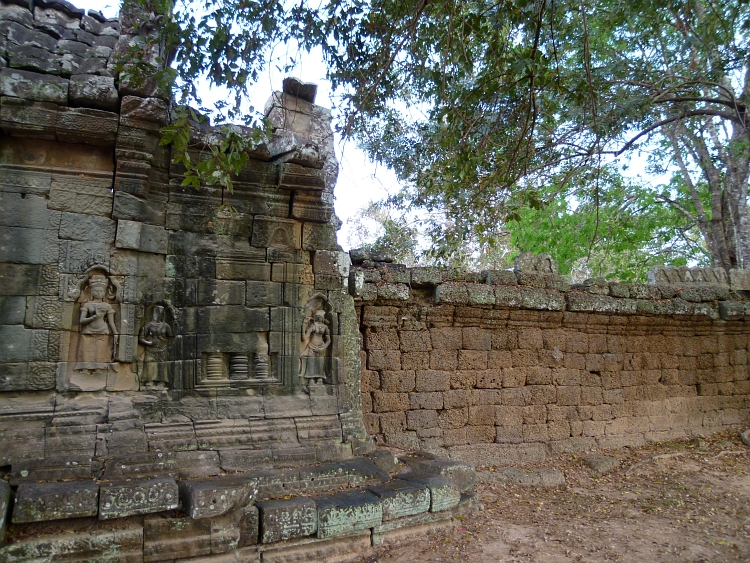
After the fall of the Khmer empire in the 15th century, the temple of Ta Prohm was abandoned and neglected for centuries. It was later 'discovered' by the French explorer Henri Mouhot in 1860, though surely local residents knew about it already. The following year Mouhot died of malaria in Luang Prabang — a town in Laos that Lisa and I later visited ourselves.
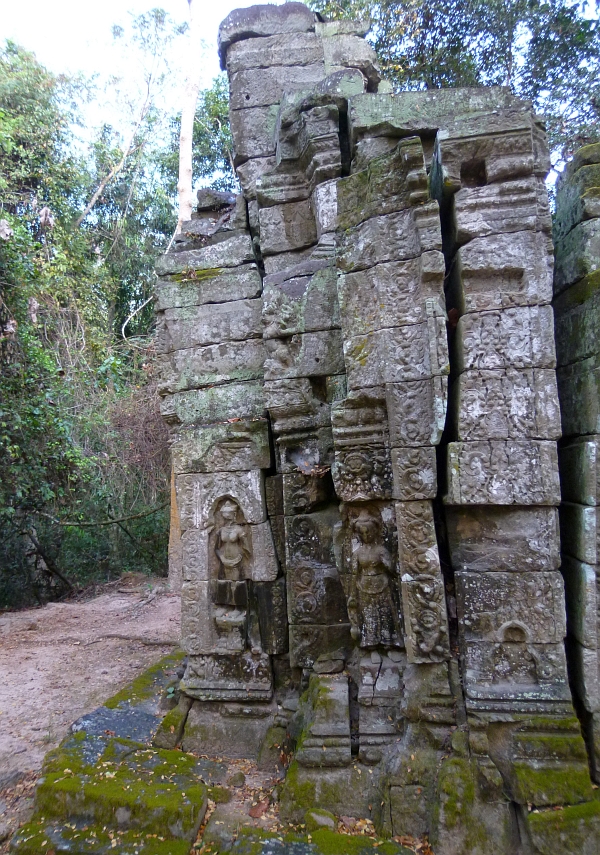
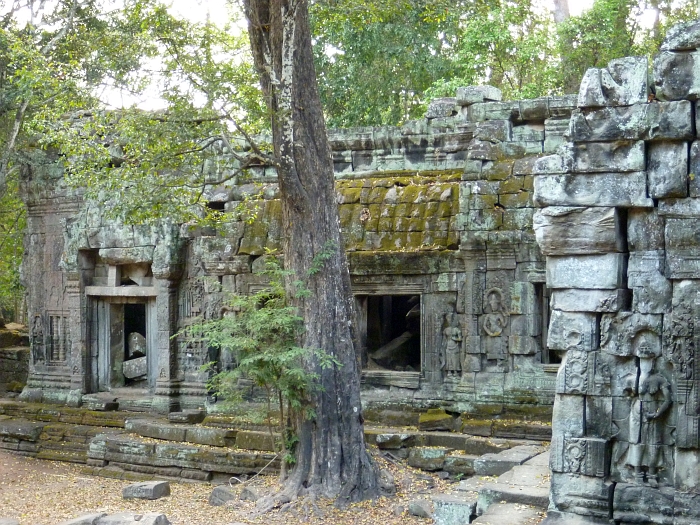
In Mahayana Buddhism, Prajñāpāramitā means 'the perfection of wisdom'. It is often personified as a female figure, and Ta Prohm is dedicated to her. But King Jayavarman VII also constructed Ta Prohm in honor of his family... and they say the figures of Prajñāpāramitā are modelled on his mom! Prajñāpāramitā is also the name of a collection of writings, or sūtras, which were important in Buddhism starting around the first century BC. For example, the Vajracchedika Prajñāpāramitā Sūtra or "Diamond Cutter of Perfect Wisdom" says, among other things:
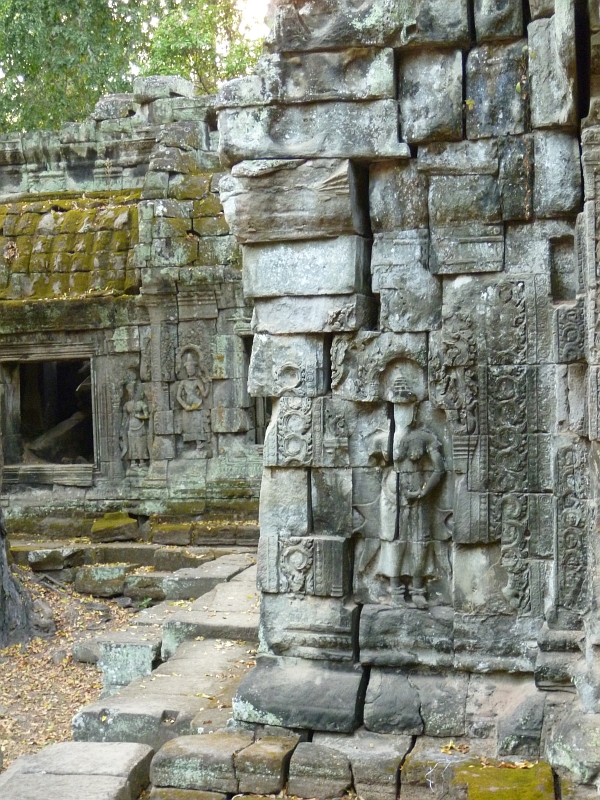
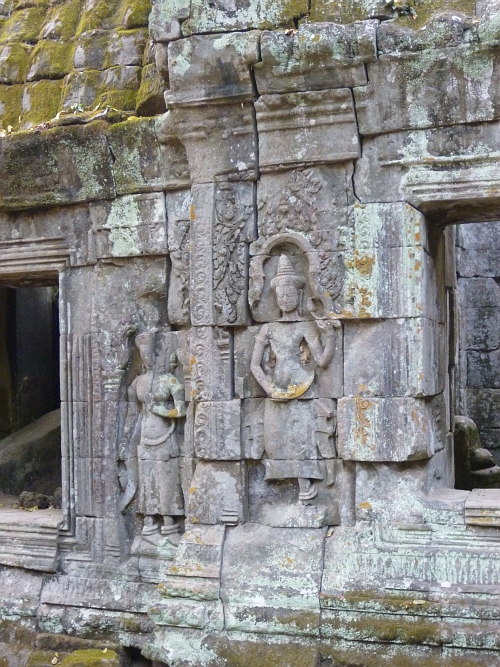
Here is a statue, I guess a Buddha, in the ruined main building of Ta Prohm:
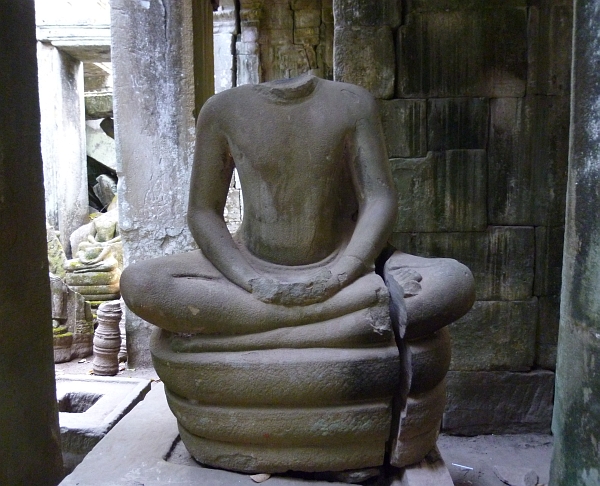
But what everyone likes most about Ta Prohm is the trees! When the École Française d'Extrême-Orient started restoring the temples around Angkor Wat, they decided that Ta Prohm would be left largely as it had been found, as a "concession to the general taste for the picturesque." Very smart.
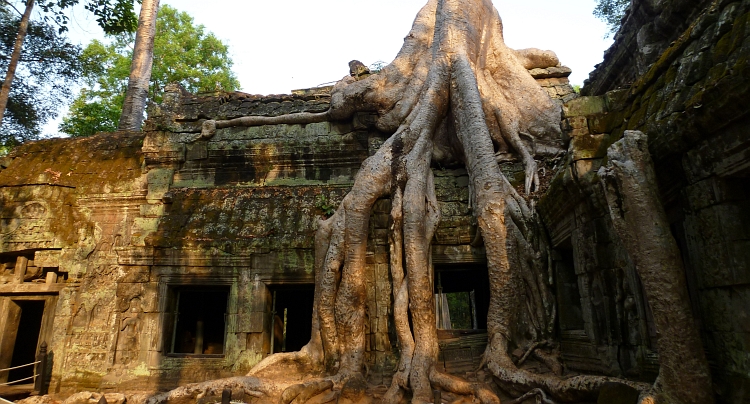
You can teleport yourself there and see what you think!
Two kinds of trees dominate Ta Prohm, but nobody can agree what they are: the big ones are either silk-cotton trees or thitpoks, and the small ones are either strangler figs or gold apples. The Angkor scholar Maurice Glaize wrote: "On every side, in fantastic over-scale, the trunks of the silk-cotton trees soar skywards under a shadowy green canopy, their long spreading skirts trailing the ground and their endless roots coiling more like reptiles than plants."
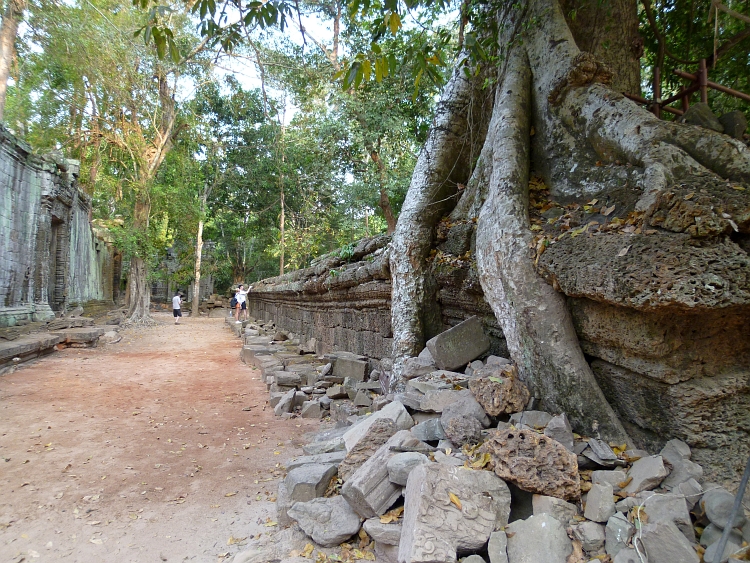
Below we see a tree — let's say it's a strangler fig, that sounds suitably ominous — in front of some wall carvings at Ta Prohm. Is the female figure at left Prajñāpāramitā? The small dancer at right is an apsara:
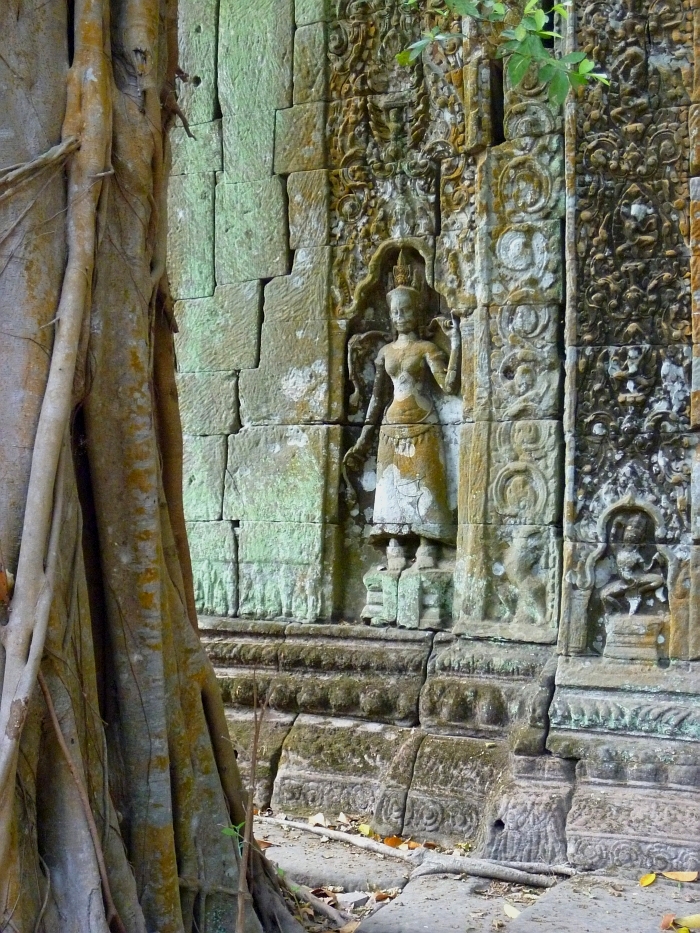
Over the centuries, the trees have knocked down enormous stone structures at Ta Prohm like children bored with their blocks.
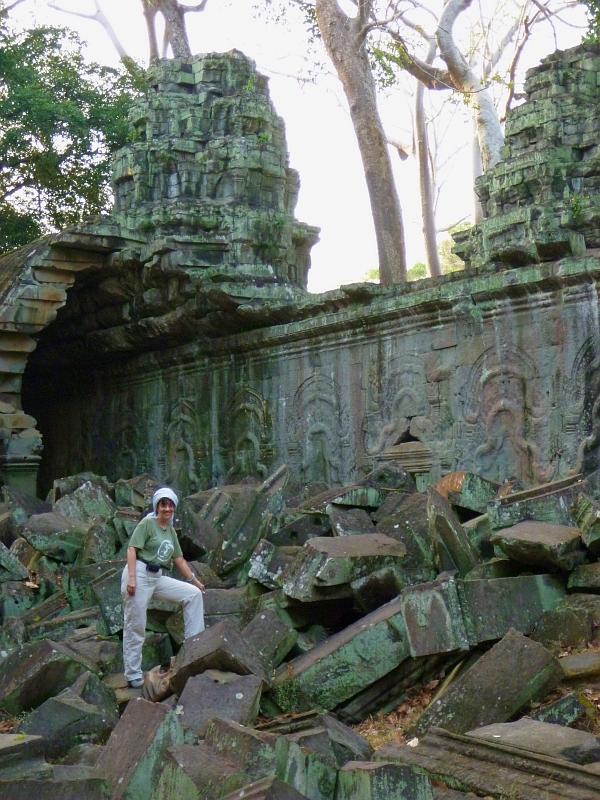
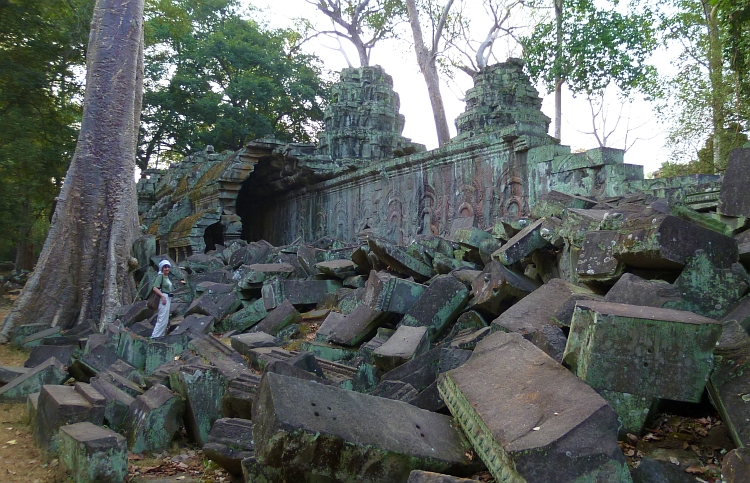
While Lisa was fiddling with her camera, this strangler fig snuck up from behind and tried to grab her:
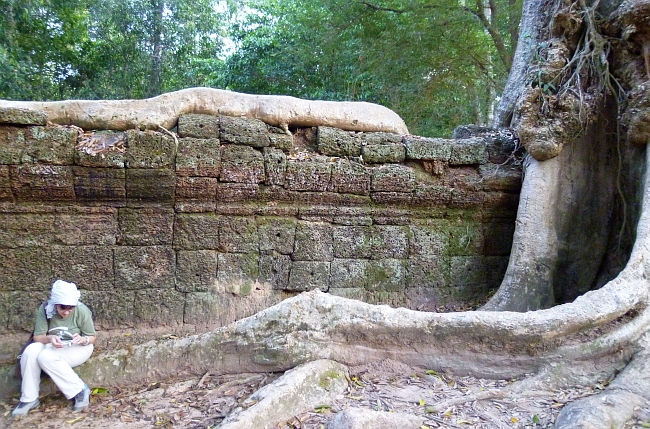
I had to fight it off with my bare hands. For another amazing view, go here.
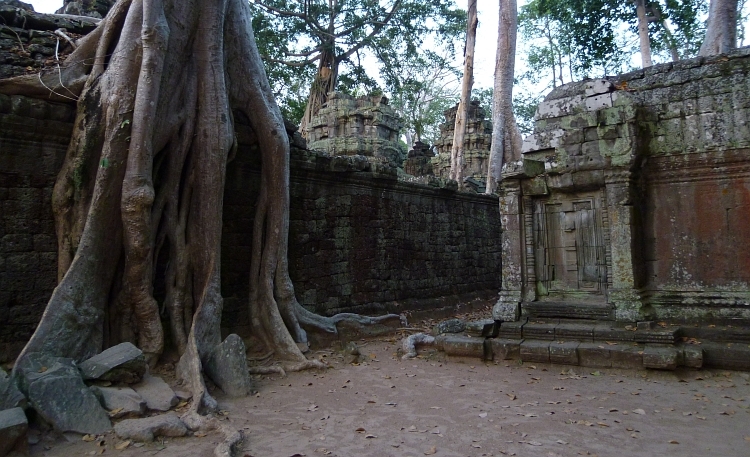
Our visit to Ta Prohm was cut short by sunset. Here is one last image of this magical place:
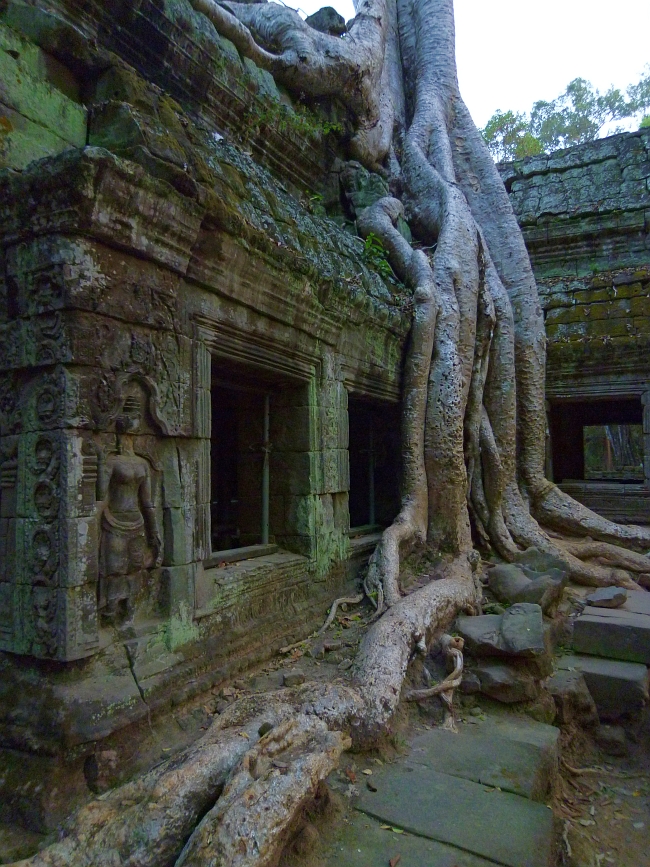
If you ever go to Angkor Wat, make sure to visit Ta Prohm!
February 26, 2011
If you like Sherlock Holmes stories, you should go back and read their
predecessor, the first great detective novel in the English language:
I just finished it — it's great fun! It features an innovative style where different characters tell different parts of the story. It also features a brilliant detective, many layers of mystery one wrapped inside another, and a romantic theme: the theft of a large diamond, the Moonstone, which had once graced a Hindu temple and now bears a curse. T. S. Eliot called it "the first, the longest, and the best of modern English detective novels." Dorothy Sayers, who I trust more on these matters, called it "probably the very finest detective story ever written". As the Wikipedia article points out, it introduced a shockingly large number of tricks that were later to become standard in the mystery genre:
© 2011 John Baez
baez@math.removethis.ucr.andthis.edu